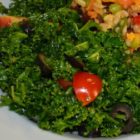
If you caught my recent post about a low FODMAP diet, you got a little insight into what the low FODMAP diet is and if it might be right for you. Today, I’m going to dive a little deeper into this diet to provide some more context and education.
As a refresher, FODMAP is an acronym for specific types of carbohydrates (sugars and fibers) that are often poorly digested. They are either absorbed very slowly or not at all, and as a result, sensitive individuals experience a wide range of symptoms, including but not limited to: bloating, pain, or diarrhea.
Here’s a breakdown of the acronym:
- Fermentable – Gut bacteria ferment (or eat) undigested carbs and produce gas as a result
- Oligosaccharides – sugars including fructans and galacto-oligosaccharides (GOS) found in wheat, rye, barley, onions, garlic, and legumes
- Disaccharides – lactose, which is found in dairy products
- Monosaccharides – fructose, a simple sugar found in honey, agave, and certain fruits and vegetables such as apples, pears, mango, and asparagus
- Polyols – found in certain fruits and vegetables including blackberries and mushrooms, as well as some low-calorie sweeteners
Benefits of a Low FODMAP Diet
Eliminating FODMAPs from your diet can lead to a reduction in digestive symptoms for about 75% of people with Irritable Bowel Syndrome (IBS).
Eliminating FODMAPs from your diet can lead to a reduction in digestive symptoms for about 75% of people with Irritable Bowel Syndrome.
This means less bloating, less gas, less abdominal pain, and less diarrhea in intolerant individuals. So, it’s a great place to start if you have IBS or other relatable digestive struggles.
How Do I Get Started with a Low FODMAP Diet?
The low FODMAP diet is a 3-phased process designed to provide you with relief from your symptoms. Here’s a breakdown of the three phases.
Phase 1: A 2-6 week elimination diet that involves removing all high FODMAP foods from your diet. This is a temporary, therapeutic diet to help pinpoint exactly what foods trigger symptoms for you.
Phase 2: A 6-8 week period of reintroducing high FODMAP foods back into your diet and assessing your reaction. This helps you discover which foods and at what portion sizes might be causing your issues. This also helps you identify which high FODMAP foods your body can more easily tolerate.
Phase 3: The ongoing period. This is a personalized FODMAP diet that is intended for long-term symptom management. Low FODMAP foods you tolerate are all included in a tailored eating plan that helps you manage your symptoms.
Before You Begin…
Before you begin a low FODMAP diet, there are a few things you need to do:
- Check with your doctor that this diet is right for you
- Understand the 3-phased approach. This is NOT meant to be a forever plan.
- Have questions or are unsure where to begin? Consult a trained dietitian who can help guide you step-by-step through the process and get you on your way to relief.
- Eating Behavior (47)
- Grocery Shopping Tip (9)
- Gut Health (42)
- Healthy Eating (49)
- Low FODMAP (13)
- Nutrition Articles (32)
- Recipes (27)
- Uncategorized (4)


